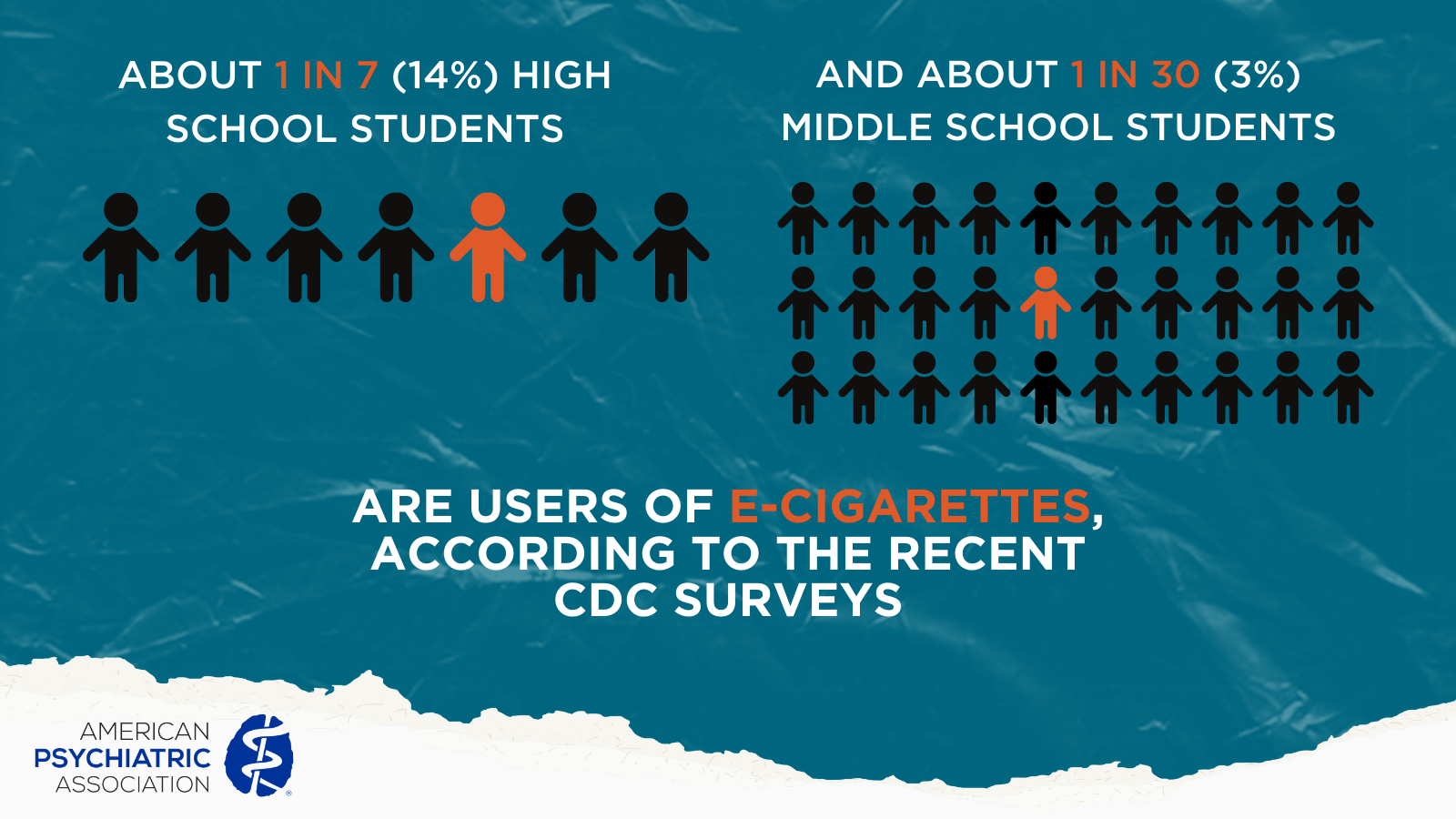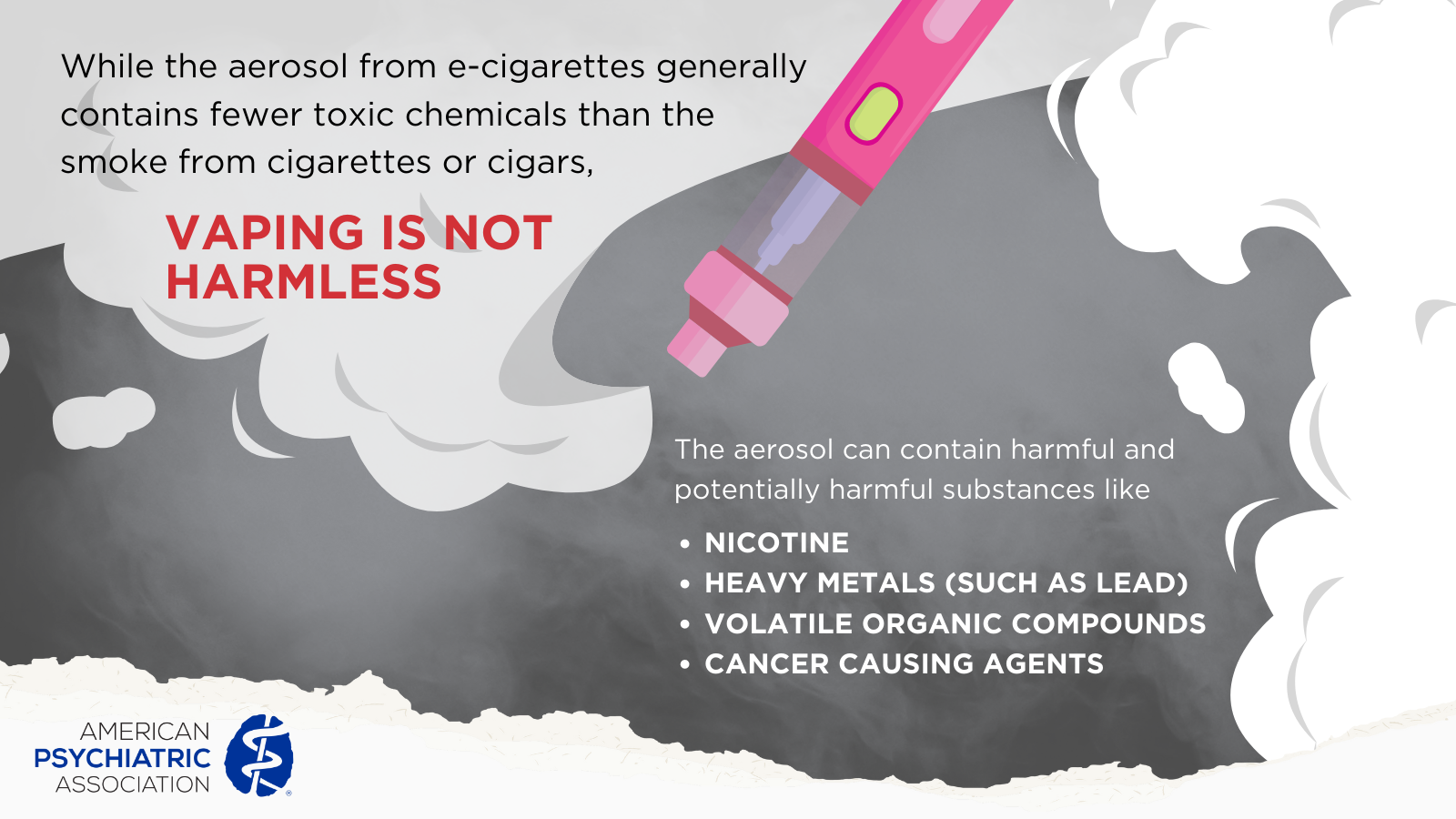The use of e-cigarettes, or vaping, involves using electronic cigarettes to inhale vapor created from a liquid heated inside a device. The devices use batteries to power heating elements that create the vapor that is inhaled by the user. E-cigarettes take different forms: some look like regular cigarettes or pipes and some look like pens, flash drives and other everyday items.

According to recent surveys
- E-cigarettes have become the most commonly used tobacco product among youth since 20141
- Middle and high school students use e-cigarettes at increasing rates1
- about 1 in 7 (14%) high school students.
- about 1 in 30 (3%) middle school students.
- Among students using e-cigarettes, most use flavored e-cigarettes
- 86% of high school students.
- 82% of middle school students.2
While the aerosol from vaping generally contains fewer toxic chemicals than the smoke from traditional cigarettes, it is not harmless. The aerosol can contain harmful substances, including nicotine, heavy metals like lead, volatile organic compounds, and carcinogens (cancer-causing agents), according to the CDC.
Most e-cigarettes (vapes) contain nicotine—the addictive drug in regular cigarettes, cigars, and other tobacco products. Nicotine can harm the adolescent brain which continues developing until about age 25. Using nicotine in adolescence can harm the parts of the brain that control attention, learning, mood, and impulse control.3
E-cigarettes may also contain toxic metals, such as arsenic and lead. The heating elements in the devices may also generate volatile organic compounds, including acetaldehyde and formaldehyde.4
When teens use nicotine, it may also increase the risk for current and future addiction to other drugs.5
Having symptoms of depression increases the likelihood of a teen using e-cigarettes. And using e-cigarettes is associated with worsening symptoms of depression. (Lechner 2017) Youth who use e-cigarettes are more likely to have a history of depression and more frequent use is associated with a greater likelihood of experiencing depression.4
Student surveys have found:
- The most common reason U.S. middle and high school students give for trying an e-cigarette is “a friend used them.”
- The most common reason youth give for continuing to use e-cigarettes is “I am feeling anxious, stressed, or depressed.”3
Teens may turn to vaping to try to deal with stress or anxiety. But that use can become a cycle of nicotine dependence.

Recent studies have found that most youth and young adults who use e-cigarettes want to quit. One study found that more than half of middle and high schoolers who use e-cigarettes said that they intend to quit and about two-thirds had tried to quit during the past year.6
Another study that surveyed more than 1,000 youth and young adults, 15 to 36 years of age similarly found that a majority of young e-cigarette users want to quit.7
Scientists are still learning about the effects of quitting vaping on mental health, according to the CDC. Quitting smoking cigarettes is associated with lower levels of anxiety, depression, and stress and improved mood and quality of life.8
Resources on Quitting
- Nicotine replacement therapies, such as nicotine patches or gum, inhaler or nasal spray can reduce withdrawal symptoms and cravings, helping people quit vaping more successfully.
- Behavioral counseling and support groups can also be beneficial in overcoming addiction to vaping.
- Two daily medications, bupropion (Wellbutrin) and varenicline (Chantix) are FDA-approved to help with quitting vaping. Primary care doctors can discuss and prescribe these medications.
- For those who don’t stop vaping completely, reducing vaping over time or using lower-concentration products may help reduce health risks.
- Smokefree.gov to connect to individual state quitlines
- Call 800-QUITNOW (800-784-8669) - National Cancer Institute Smoking Quitline - to connect with a tobacco cessation counselor
- Call 877-44U-QUIT (877-448-7848)
- Online chat at LiveHelp
- Text QUIT to 47848
